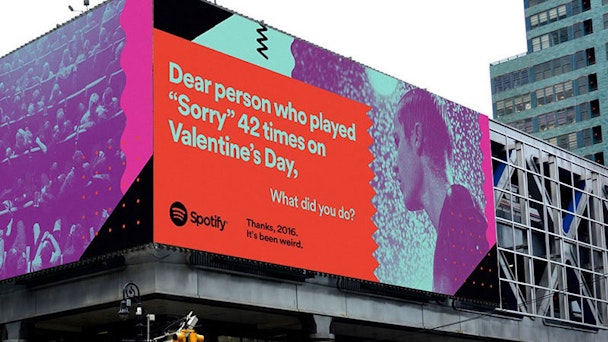Film, art, data, personalisation, tech, creative – it’s all meaningless unless you make people feel
There’s been talk recently of a split in the advertising industry, between ‘traditional’ creative campaigns vs. content influenced and informed by data. However, whether the idea takes the form of film, art, web interfaces or technology such as AI, it’s all meaningless unless you make people feel something.

Spotify created a series of personalised ads at the end of 2016 using its user data
Data in itself is inert. The ability to transform that data into work that is meaningful, emotive and immersive is where the alchemy takes place; with creative genius and ideas the galvanising force. Equally, ideas so brilliant that they spark fame and even penetrate our common cultural currency account for little if they don’t reach their intended audience.
Creative teams need to embrace data’s contribution, and vice versa. Just as it’s impossible to imagine Laurel without Hardy, or Holmes without Watson’s insights - data smarts and creativity simply can’t reside in separate camps within a divisive narrative.
Much has been made of the supposed split between traditional creative and ‘new’ creative in our industry. The purpose and fate of the former, typified by purist creativity - the heartland (or so the thinking goes) of powerful micro films, bold TV and risk-taking print campaigns - is to connect to people and inform culture. On the other side, allegedly, lives data-driven marketing collateral that targets precisely and offers innovative ways to connect with audiences.
However, for me, this is an entirely meaningless debate. Worse, it sets back the dial to outdated divisional modes of thinking and distances us from our ultimate goal in advertising. To my mind, this has always been – and always will be – to make something that resonates with people.
For all the headline-friendly predictions of a split industry, there is in fact no ‘us’ vs a perceived ‘them’. Whichever way you go about creating an advertising campaign, there is a unifying factor that guarantees its success or failure: how it makes people feel.
Technology and creativity are not mutually exclusive
A lot of people have bemoaned the death of truly creative ideas. They say technology has led to the death of creativity. But this couldn’t be further from the truth.
Creativity has brought technology out into the open, and technology has helped the creative industry smash through new frontiers. You can create close to anything these days. We’re all familiar with ads are created with CGI – built out of CAD data. These examples of tech-driven creativity are so believable, textured and alive that people no longer think of them as artificial.
But just because you can, doesn’t mean you should. No matter which way you approach a campaign, whether through algorithms, CGI or camera trickery – don’t overcomplicate things. Our mantra should be to keep it simple. Start with the idea, and then work backwards. Don’t use a piece of technology, for the sake of it. Technology is not (and never should be) the focal point.
Remember too that the essence of good, impactful creative work lies in making it simple. If an approach feels complex to you, don’t do it, because the end result will inevitably confuse people.
Most importantly – make people feel
Creating a feeling should always be the unifying factor. The first and last question to ask throughout the campaign development is ‘how will your campaign make the audience feel?’ Will it make them happy, sad, angry? And then…will it inspire action?
Good creative is measured on how people feel after experiencing it, not whether it was achieved with a tech or creative approach. As the debate rumbles on, with the challenge of balancing the two disciplines, we should never lose sight of our end goal.
Ian Haworth is executive creative director at Wunderman UK and EMEA.
